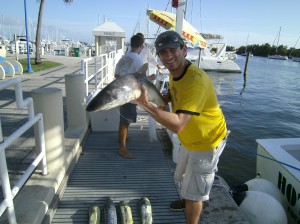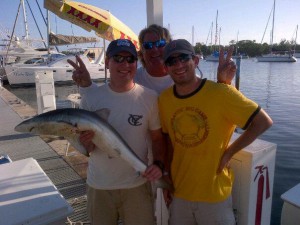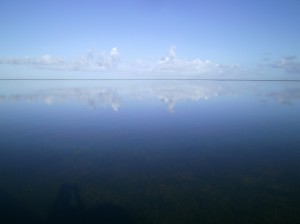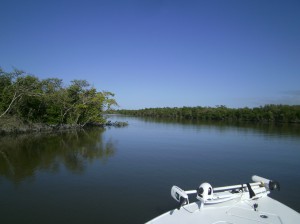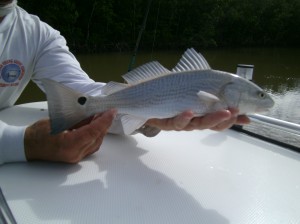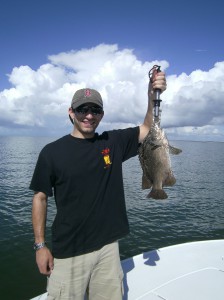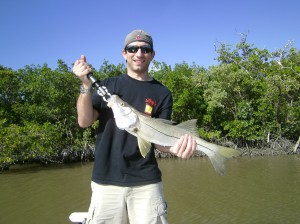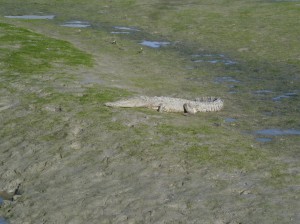Back in September, I tried to go out for some redfish on the flats of the Biloxi Marsh, but the weather conspired against me. Luckily, I found myself needing to get back down to New Orleans for a wedding, so I called up Captain Greg Moon of Louisiana Fly Fishing Charters to get me back out on the water. The perfect timing of the wedding got my Christmas vacation started a little early with a flight down to the Crescent City on Wednesday night just in time to grab a fantastic po’boy from Tracey’s before resting up for my Thursday excursion. The excitement of targeting this bull redfish was already building, and sleep did not come easily.
Captain Greg picked me up from the hotel early on Thursday. Even though my hotel was right on Canal St., I’m not sure how he managed to navigate that trailer through the old city streets. We headed southeast towards the launch, stopping at Penny’s Cafe for a hearty breakfast and to pick up some sandwiches for lunch. I had one of the best ham and cheese omelettes my taste buds have ever had the chance to savor. This was starting off to be a great trip.
We got down to the boat ramp, and Greg pushed us off and started motoring through the bayou. Despite the relatively warm forecast temperatures, I was glad I made the last second decision to pack my Under Amour and sweatshirt. We pulled off to our starting point, and Greg readied the fly rod. Since this was my first time on the flats for reds, he explained what I’d be looking for, what he’d be doing to get me in the right position, and how I’d need to present the fly and set the hook. We weren’t going for slot reds, so this trip would be all strip sets as if we’re targeting tarpon. I stepped up to the casting platform and readied my line. Greg had barely finished the instructions before I look down and see a giant redfish maybe 10 feet off the boat. Unfortunately, this one was too close to really do anything with, and it swam off to the horizon.
A few minutes later, I spot another redfish. Like the first, this one looked enormous – or in Greg’s words, a “donkey.” I laid down a perfect cast, and Greg says, “Strip! Strip!” The bull turned on the fly and inhaled it! In the moment of excitement, I lifted the tip and the rod bent in half. The weight of the fish became quickly apparent, then suddenly, everything went quiet. There was no longer a brick on the end of the line, and no longer a bend in the rod. Remember when I said the fly would need to be strip set? Well I didn’t. The trout-strike just didn’t have enough power behind it to drive the hook point into the tough mouth of the redfish, and it popped the hook out of its mouth. I hope I don’t make that mistake again.
What looked like it was a beautiful day to my untrained eye turned out to be actually somewhat challenging conditions. The past several days had seen nearly perfect conditions – light prevailing winds, bluebird skies, and lots of hungry fish. For my trip, a new weather system came through, bringing moisture in from the gulf. We had some clouds come through, plus slightly hazy skies – which makes it incredibly difficult to see fish. The wind changed from the prevailing northerly direction to coming in from the south, which made water levels change. A full moon likely had the fish feeding all night. All these conditions combined for finicky, spooky, difficult to see fish. Luckily, I had Greg on the push pole.
We kept getting stifled by the spooky fish, or by the time we could even see them, the boat would be on top of them. Greg moved us on to another flat and set up the drift. Shortly thereafter, Greg spots a big “floater” – which is just like what it sounds. The redfish looked like on the surface. “9 o’clock!” he calls out. I peer off the side of the boat, but just can’t pick it up. Greg starts feeding me more location details as I start up a cast blindly. “Give me 30 feet, 9 o’clock! It’s the it’s orange blob!” I still can’t pick it up the fish, but could manage to hook myself mid-cast. Of course, as soon as I do that, I see the bright, jack-o-lantern-like redfish glowing on the surface. It’s simply astounding that I couldn’t find it in the water to begin with, but that’s what comes with experience and bow time for this type of fish. All was not lost, though, Greg kept a bead on the fish while I untangled myself. Sure enough, it disappeared from my sight again somehow. Greg kept trying to give me directions on the fish as it swam off out of reach and permanently out of sight. I guess all was lost on that fish.
Despite my screw-ups, Greg wasn’t deterred. He moved us to another flat, and sure enough he found the fish one more time. This time, every direction we looked, we had some donkeys swimming around us. I cast at one, but it spooked. Greg saw one he wanted me to target and called it out. Once again, I couldn’t find the fish. I cast blindly in the direction Greg was telling me. I somehow managed the right distance, and managed to get it pretty close to the fish. “Pick up and go a few feet left,” Greg instructed. “Strip, strip, strip!” I managed to pick up the fish at this point. Suddenly, I felt the resistance on the end of the line. My instincts still started the lift of the rod, but I corrected myself halfway through and gave the line a good, strong tug.
This time, the hook stuck. The fish took off, immediately cleared the line from the deck, and started peeling off backing. Between my hoots and hollers, you couldn’t wipe that grin off my face. I’d reel in a little line, and lose a little more. I started gaining some ground, finally getting all the backing back on the reel. The redfish must have sensed this and made another blistering run. Greg explained how to “put the wood to the fish” so we didn’t unnecessarily prolong the fight. Sure enough, it worked, and the fish gave up the good fight.
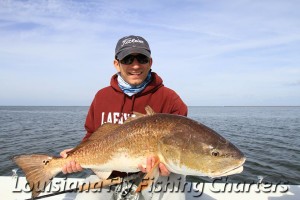
29 pound redfish with Captain Greg Moon of Louisiana Fly Fishing Charters
Greg dipped the net and got the fish. My first redfish on the fly was successfully put in the boat. Always prepared, Greg pulled out his big camera, positioned me with the fish, and snapped away masterful a few masterful photos. That’s right – not only can the man put a first-timer on a big fish, he can take a damn good picture of it too. After the photo session, it weighed in at 29 pounds on the bogagrip before he had me release it to swim another day.
I had another shot or two at fish the rest of the day. Despite a couple well placed casts, we could only drum interest up from the fish instead of another bite. With the lighting challenges being difficult enough, the sun began falling lower in the sky making sight fishing near impossible. We called it a day – a fantastic one at that.
If you’re itching for some of the best redfish fishing in the world, you really can’t beat Louisiana. Combining that with a trip to such an incredible city like New Orleans, and I’m hard pressed to come up with a better vacation. When you go, I highly recommend looking up Captain Greg Moon. Everyone knows the “best” guide for an area, but few that make those claims actually have fished with more than one or two – so I can’t tell you if Greg is the best. What I can tell you is that Greg will work his butt off to put you on a fish. He’s a guide that knows the area extremely well, knows how the fish will react and respond to different weather situations, and knows how to coach his clients. Whether you are a seasoned pro or it’s your first time on the flats, Greg will give you a fantastic chance at putting a bull redfish in the boat.
Ready to book? Give Greg a call at (702) 497-1673. Additional contact information is on his website. Don’t forget to check out his photo gallery for some seriously amazing pictures of fish his clients have put in the boat. Half day trips run $450 for up to 2 people, and full day trips go for $600. Once you go, come back and leave a review!
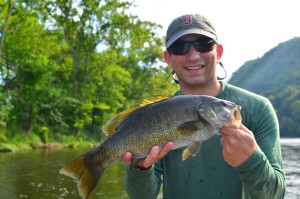 The next fish slurped the fly like a trout taking in a midge. It barely even left a surface riffle. It was a true sign of a giant. Sure enough, my 7-weight bent hard. We battled back and forth, and I struggled keeping it out of the submerged grass. Matt gave me pointers on properly fighting the bronzeback. Go figure, after 15+ years of chasing smallies on the fly, you can still learn the right way to fish and fight fish. Matt netted my quarry. It measured just over 20 inches – a Virginia citation fish.
The next fish slurped the fly like a trout taking in a midge. It barely even left a surface riffle. It was a true sign of a giant. Sure enough, my 7-weight bent hard. We battled back and forth, and I struggled keeping it out of the submerged grass. Matt gave me pointers on properly fighting the bronzeback. Go figure, after 15+ years of chasing smallies on the fly, you can still learn the right way to fish and fight fish. Matt netted my quarry. It measured just over 20 inches – a Virginia citation fish.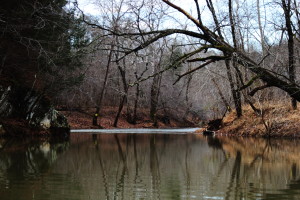
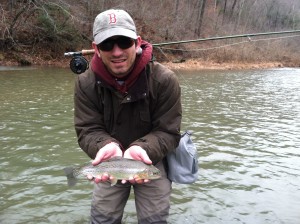
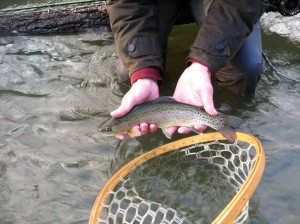
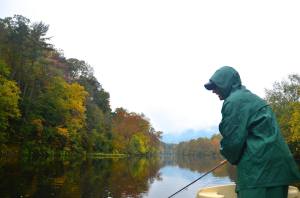

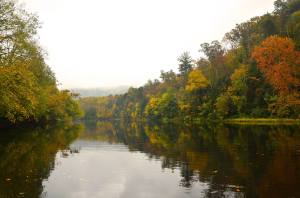
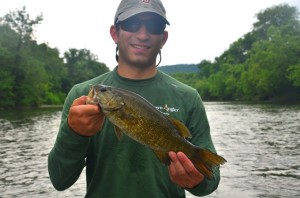
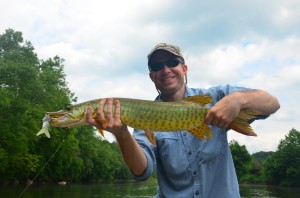
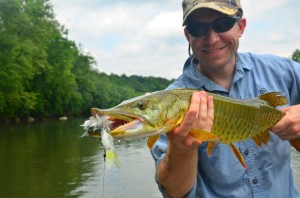
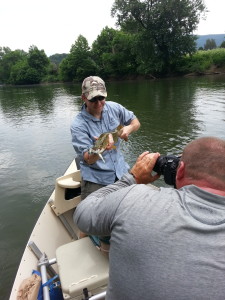

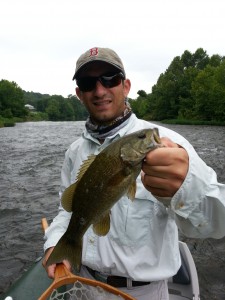
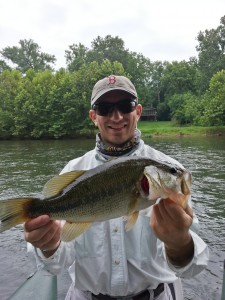
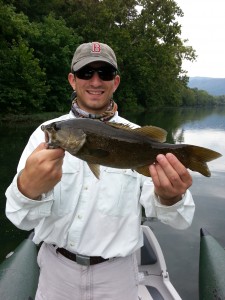
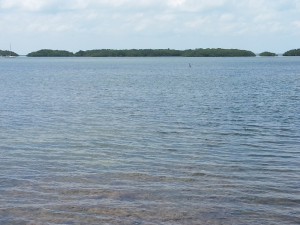
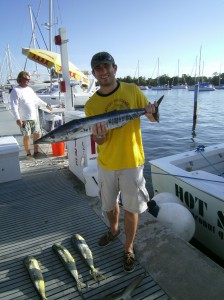 Once we got to our fishing grounds, Chris rigged up the rods, clipped them to the outriggers, and we started our troll. Not 5 minutes in, our down bait gets hit. I grab ahold of the rod and start cranking away. A couple minutes later, I have a beautiful 10-15 lb wahoo at the boat. Chris gaffed it and tossed it in the icebox. The morning was off to a great start. Chris reset the bait as Sig kept the troll going. A little while later, we start getting another hit on the down bait. This time Kyle grabs the rod, and brings in a smaller mahi mahi. Chris reset the baits and we readied ourselves for the next one.
Once we got to our fishing grounds, Chris rigged up the rods, clipped them to the outriggers, and we started our troll. Not 5 minutes in, our down bait gets hit. I grab ahold of the rod and start cranking away. A couple minutes later, I have a beautiful 10-15 lb wahoo at the boat. Chris gaffed it and tossed it in the icebox. The morning was off to a great start. Chris reset the bait as Sig kept the troll going. A little while later, we start getting another hit on the down bait. This time Kyle grabs the rod, and brings in a smaller mahi mahi. Chris reset the baits and we readied ourselves for the next one.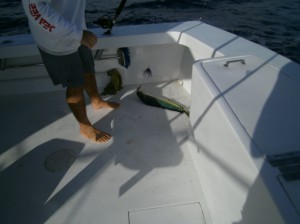 The morning grew later and Kyle and I were relaxing with a beer (come on, it’s 5 o’clock somewhere), when suddenly we saw a mahi mahi skipping through the air behind the boat. Sure enough, seconds later, it took a bait. I grabbed the rod and started the fight, but it managed to shake the hook. Through the rest of the morning, we put two more mahi mahi in the boat. We were hoping to find a school of the mahi so we could toss a fly line out to them, but no such luck. Sig asked us if we wanted to change things up, which meant it was time to go sailfishing. Sig set course for the sailfish grounds while Chris got the spinning rods rigged up.
The morning grew later and Kyle and I were relaxing with a beer (come on, it’s 5 o’clock somewhere), when suddenly we saw a mahi mahi skipping through the air behind the boat. Sure enough, seconds later, it took a bait. I grabbed the rod and started the fight, but it managed to shake the hook. Through the rest of the morning, we put two more mahi mahi in the boat. We were hoping to find a school of the mahi so we could toss a fly line out to them, but no such luck. Sig asked us if we wanted to change things up, which meant it was time to go sailfishing. Sig set course for the sailfish grounds while Chris got the spinning rods rigged up.